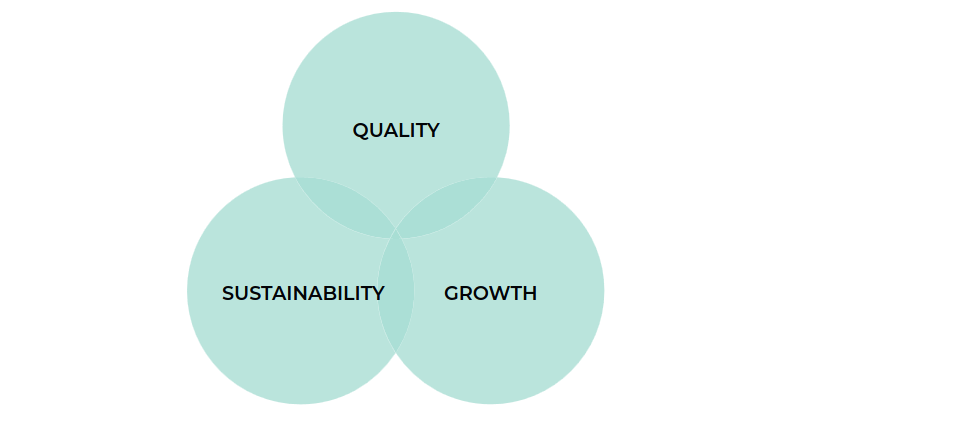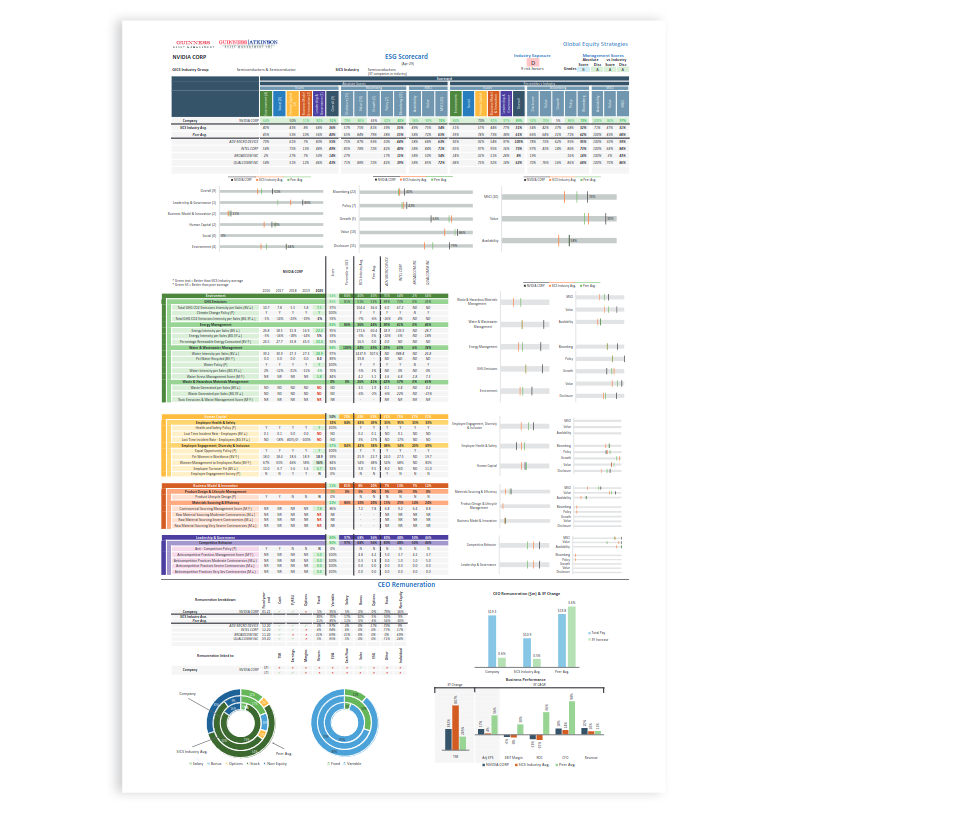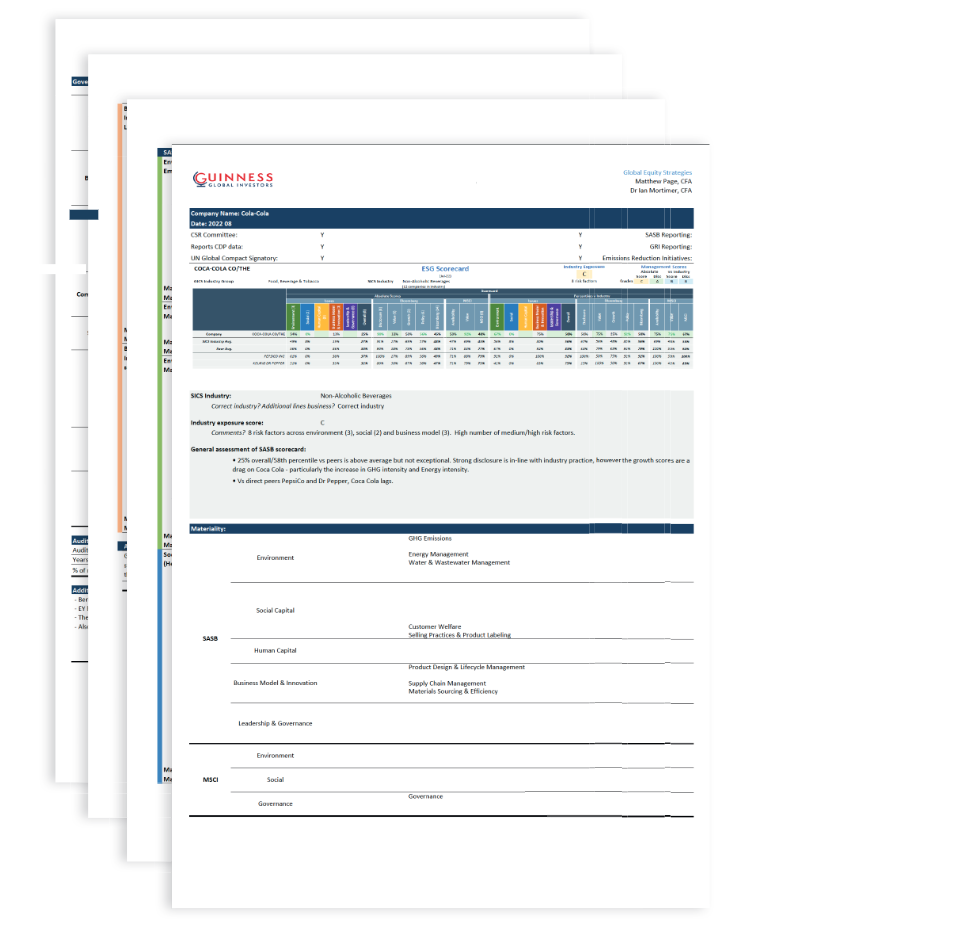Our Approach to Sustainable Investing and ESG

INTRODUCTION TO SUSTAINABLE INVESTING & ESG
DEFINING ENVIRONMENTAL, SOCIAL AND GOVERNANCE (ESG)
Fundamental data and rigorous research have always been the cornerstones of our investment process at Guinness Global Investors. Whilst Environmental, Social and Governance (ESG) factors have been integral in our company analyses, the emergence and evolution of new data sources has allowed us to establish a more thorough framework, harness additional investment insights, and launch the Guinness Global Quality Mid Cap Fund.
ESG refers to measuring and assessing the potential risk and opportunities from environmental, social and governance factors. Environmental criteria consider how a company performs as a steward of nature; social criteria examine how it manages relationships with employees, suppliers, customers, and the communities where it operates; and governance deals with a company’s leadership, executive pay, audits, internal controls, and shareholder rights.
As a proud signatory to the Principles for Responsible Investments (PRI), we are committed to adopting and implementing responsible investment principles in a manner that is consistent with our fiduciary responsibilities to clients. We do this by incorporating ESG analysis into our investment process and engaging with investee companies on ESG issues.
DEFINING RESPONSIBLE & SUSTAINABLE INVESTING
The jargon used to describe responsible or ESG investing has become increasing nuanced, confusing, and overlapping as investors have sought their own differentiated approach. Whilst the same labelling can represent different things to different people, we generally find that ‘Responsible Investing’ describes the entire spectrum of ESG-related investment methodologies.
The PRI defines responsible investment as “a strategy and practice to incorporate environmental, social and governance (ESG) factors in investment decisions and active ownership.” There are several components to responsible investing, which the PRI summarises as follows.

Even under the PRI definition, as described above, responsible investment may involve a combination of integration, screening, and thematic approaches, each with various applications depending on the investment manager. Broadly, we believe this gives rise to the following spectrum of ESG-investing approaches with increasing degrees of intentionality:

The Guinness Global Quality Mid Cap Fund is classed as a ‘Sustainable’ fund – one where we prioritise the identification of companies whose products and services have a positive environmental or social effect and whose ESG practices are good or improving.
We do not target any one specific environmental or social objective at the fund level. However, we do target businesses that individually contribute to their own, or possibly overlapping, environmental or social outcomes.
OUR INVESTMENT PHILOSOPHY
The Guinness Global Quality Mid Cap Fund is constructed as a concentrated portfolio of high-quality, mid-cap focused, growth businesses with sustainable products and practices. ESG incorporation is directly and indirectly implemented across the core tenets of the Fund: quality, sustainability and growth.

- QUALITY – Although the word ‘quality’ can be used in different ways, we believe that for a company to be described as such it must consistently be able to create value at all points through a business cycle. We identify such companies by filtering for high persistent cashflow returns on investment; we believe these companies are well run, and that this is reflected in the fact that they have consistently achieved a return on capital greater than their cost of capital.
Though we are analysing historic (or backward-looking) data, we find a high probability that a company with a high persistent return on capital will continue to achieve these high returns in the future.
As we note later, we find that by actively seeking quality businesses, we indirectly screen out weaker ESG businesses from a practice perspective. Intuitively, higher quality businesses are better run companies which naturally manage risk and opportunities (and specifically ESG risks and opportunities) better than an average company.
- SUSTAINABILITY – We take a three-pronged approach to sustainable investing:
 A. Negative screening – At the universe construction stage, exclusionary screens are applied in order to filter out companies whose products or services are harmful or whose ESG practices are sub- standard. Specifically, we exclude companies which derive material revenue from industries such as alcohol, tobacco, nuclear energy, fossil fuels and weapons. We also exclude those companies which score as ESG laggards based on their business practices. These companies tend to display inadequate or worsening management of ESG issues and can be quite vulnerable to ESG-related disruptions and controversies.
A. Negative screening – At the universe construction stage, exclusionary screens are applied in order to filter out companies whose products or services are harmful or whose ESG practices are sub- standard. Specifically, we exclude companies which derive material revenue from industries such as alcohol, tobacco, nuclear energy, fossil fuels and weapons. We also exclude those companies which score as ESG laggards based on their business practices. These companies tend to display inadequate or worsening management of ESG issues and can be quite vulnerable to ESG-related disruptions and controversies. B. Positive sustainability alignment – We use sustainability themes to guide whether a business’s products and services can be deemed sustainable – and to what extent. Each holding must have products and services that are enabling or exposed to the transition to a more sustainable economy. In this manner, we are actively seeking positive sustainability opportunities.
B. Positive sustainability alignment – We use sustainability themes to guide whether a business’s products and services can be deemed sustainable – and to what extent. Each holding must have products and services that are enabling or exposed to the transition to a more sustainable economy. In this manner, we are actively seeking positive sustainability opportunities. C. Active ownership – We believe that being active stewards, through proxy voting and direct engagement, is an important role of an investment manager. We do this not just because it is good in itself, but also with the aim of improving the operational performance of investee companies and mitigating their manageable risks.
C. Active ownership – We believe that being active stewards, through proxy voting and direct engagement, is an important role of an investment manager. We do this not just because it is good in itself, but also with the aim of improving the operational performance of investee companies and mitigating their manageable risks.
- GROWTH – Whilst no single metric will enable us to identify companies which will have high future growth, we believe that looking in the mid-cap space is an attractive place to start. Mid-caps have outperformed both their large and small-cap counterparts over the long term by growing their earnings and revenues faster – and they have been doing so with a better risk-adjusted return.
We also find that there is significant crowding in large-cap names within ESG funds. By focusing on mid- cap companies, we not only offer investors a differentiated portfolio but we also tend to find more pure-play sustainable businesses whose products and services have higher degrees of intentionality and materiality with regards to positive environmental or social effects.
Ultimately, we seek to invest in companies exposed to long-term structural growth. Naturally the transition to a more sustainable economy has created these growth drivers which we seek to access through our sustainability themes.
Simply speaking, we believe that by seeking sustainable businesses from a product and practice perspective, we can access long-term structural growth themes whilst investing in quality businesses that are ‘doing well whilst doing good’. Further, considering ESG issues is a pragmatic part of our day-to-day activities as investors, helping to form our understanding of the business model of a company, its long- term return on capital potential and its mitigation of risk.
ESG INCORPORATION
The first approach to ESG Incorporation, according to the UN PRI, is the integration of ESG factors. The PRI defines this as “the explicit and systematic inclusion of financially material ESG information in investment analysis and investment decisions”. As long-term investors seeking to identify good quality companies across our portfolios, we believe that ESG considerations play a direct role in managing company specific risks and thus can have the potential for a meaningful impact on long-term returns.

ESG INTEGRATION – QUANTITATIVE ANALYSIS
Our bottom-up ESG framework has been developed in-house and is used to assess quantitatively the sustainability risk associated with current and potential underlying investments. Using the Sustainability Accounting Standards Board (SASB) materiality assessment we have developed a scorecard that is used to evaluate a company based on various industry-specific ESG criteria. The scorecard compares a company’s ESG metrics with its relevant industry average and its peer group. By using a systematic quantitative approach as one of our assessment tools, we are able to quickly identify strengths and weaknesses in a company’s operations from an ESG-perspective – both on an absolute level and versus peers. This can form a basis for further due diligence.
We believe – as active managers – that building our own methodology to assess ESG factors is better than relying solely on third-party scores or only using an exclusionary criterion. We use external ESG research as a starting point for our own analysis, and the data used in our scorecard comes from a wide range of third parties (including MSCI and Bloomberg) and from individual company disclosures.
Two key components of the ESG scorecard are ‘materiality’ and ‘transparency’.
MATERIALITY
We use the standards set out by SASB to identify only the material factors relevant to a company’s industry. In this way, we focus on the key risk factors that may materially affect a company’s operations and thus share price. We believe this is a superior way to assess the impact of ESG metrics on a company than a generic, one-size-fits-all framework. We map the material risk factors laid out by SASB to a combination of absolute metrics (point- in-time), trend metrics (change over time), and policy metrics (has or does not have), to assess the business’s management of these risks. This is further complemented with a company’s industry average value and Guinness-defined narrow peer group value to assess the extent to which a company is leading or lagging its peers.
TRANSPARENCY
One of the main drawbacks in using third- party scorecards is the lack of transparency. By using an in-house scorecard, we have access to greater granularity and thus can more accurately determine the drivers of a score to identify specific areas of strength and weakness – as opposed to an overall score that is not useful for due diligence purposes. Drivers of a weak score, for example, might derive from a lack of company disclosure, or conversely strong disclosure but weak absolute and growth levels.
Whilst the ESG scorecard provides us with an insight to the ESG practices of a company, we must be aware of the several drawbacks from existing data and the issues around disclosure, quality of self- reporting, consistency, and frequency:
- Disclosure – Most ESG data has been provided for less than a decade, and with no regulatory requirement for disclosure, companies can report as much or little as they please. Though disclosure seems to be improving, particularly driven by new European regulations, coverage remains particularly patchy among smaller- caps and companies domiciled in Asia and Emerging Markets. This can make comparison difficult.
- Quality – ESG data is largely self- reported, naturally raising questions of reliability and consistency.
- Consistency – Individual ESG metrics are weighted differently by various data providers. This means ESG scores from different providers have a low correlation with one another – unlike credit ratings, for example. We attempt to overcome this by building our own in-house, standardised scoring model.
- Frequency – Many ESG metrics are only updated annually. This makes it harder to fi nd timely insights to manage risk or enhance returns.
ESG INTEGRATION – QUALITATIVE ANALYSIS
Data deficiencies and a lack of contextualisation mean there is a need to go beyond headline metrics for ESG insights. To fully understand the ESG risks and opportunities, therefore, we must supplement the quantitative analysis with a rigorous qualitative sustainability assessment which covers both the products and practices of a business. The 10-page review covers:
- a product alignment assessment
- a qualitative assessment of the SASB risk metrics covered in the quantitative scorecard • exposure to negative externalities and controversies • a good governance assessment
- an executive remuneration assessment
- a carbon transition assessment
- a summary of our engagements and proxy voting record
We use public sources of information including annual company reports, sustainability (or similar) reports, press releases, NGO research, and company presentations, in addition to broker and proxy voting research.

PRODUCT ALIGNMENT ASSESSMENT
Our qualitative assessment begins with an in-depth analysis of a business’s products and services. As outlined previously, the Fund prioritises the identification of companies whose products and services have a positive environmental or social effect. To assess this, we use sustainability themes and sub-themes to guide our assessment. In doing so, we can more accurately and systematically conclude what is and what is not a sustainable product or service. To be considered for the portfolio, a company must derive the majority of its sales from our sustainability themes, which are outlined in this paper under ‘Screening’.
QUALITATIVE RISK FACTOR ASSESSMENT
Using our quantitative scorecard, alongside the other sources outlined above, we evaluate the magnitude of exposure to the material risk factors, the company’s management of these risks and whether there are any relevant company initiatives that perhaps mitigate some of them. We fi nd that third-party risk frameworks are usually constructed on an industry basis, so our assessment enables us to evaluate the nuances between various companies within an industry, delving into whether a certain risk factor is material to the company specifically.
NEGATIVE EXTERNALITIES & CONTROVERSIES
Understanding what each company does and how it operates enables us to assess whether the company is exposed to creating any negative externalities. The Fund goes beyond our company-wide exclusions to actively avoid exposure to common social and environmental exclusions. Here we assess any possible exposures to our exclusion list as well as past or current controversies that could have meaningful investment implications in the future. We detail this further in this paper under ‘Screening’.
GOVERNANCE & REMUNERATION
Further, a particular focus of our qualitative assessment is on a company’s governance and its management’s remuneration. We believe governance should incorporate a strong and effective board with the necessary skills, background, and experience to provide objective oversight of management, positive employee relations with clear and effective policies in place, and a well-structured management compensation scheme. This should comprise clear, specific, and challenging long-term performance criteria which are fully disclosed to shareholders and incentivise long-term value creation for the benefit of shareholders. Our assessment here takes a checklist approach based on the transparency, design, and alignment of short and long-term remuneration. The results not only allow us to assess the company’s governance, but also often form the basis of our proxy voting decisions and any further engagement. For more information, please refer to our paper on Our Approach to Executive Remuneration, published on our website
CARBON TRANSITION RISK
Another key feature of our qualitative sustainability assessment involves analysing the carbon transition risk of a company. Whilst environmental factors may not be deemed material for every company, we believe it is an important exercise nonetheless to assess how companies are contributing to the global risk of climate change, and what is the company’s financial flexibility given changing regulations and policies. We look at a company’s emissions over time and stress test the company’s margins, earnings, return on equity, and net debt-to-equity to differing carbon prices. Alongside this we assess the company’s broader ability to cover higher ESG-related costs (e.g., higher cost of goods from more sustainable sources) and increase investment in more ESG-related projects through higher capital expenditure or R&D (e.g., more energy efficient machinery). Ultimately, our scenario analysis allows us to assess a company’s exposure to possible carbon- related costs – through either internal investment or externally imposed costs.
As part of our carbon intensity review, we also look at the company’s initiatives to reduce its carbon footprint. Initially we find out whether the company reports data to the Carbon Disclosure Project (CDP), and then aim to evaluate whether the company has adequate science- based emission reduction targets. Again, the results of our evaluation here often form the basis of our proxy votes and engagement.
Overall, our qualitative sustainability assessment enables us to better understand the materiality and fairness of ESG scores, the risks to business models and valuations, as well as company- specific issues and opportunities. It allows us to form more complete and meaningful investment conclusions, and for this reason, both the quantitative and qualitative sustainability reviews are conducted in-house by the investment analysts and portfolio managers working on the Funds; we do not outsource this responsibility to an internal or external ESG team.
It would be remiss of us not to point out that incorporating ESG factors into investment decision-making is in its infancy compared to traditional financial analysis. While negative factors (such as oil spills or harassment) can cause a short and sharp correction in a share price once in the public domain, and therefore can lead to a long-term negative reputation for the company, positive factors (such as improving governance or management remuneration alignment) can take years to play out. It is precisely for this reason that we believe investment managers who have already established their ESG credentials, and who are actively engaging with the companies they invest in on ESG issues, can leverage a potential competitive advantage over those that do not.
SCREENING
The second approach to ESG Incorporation, according to the UN PRI, is the application of screening. The PRI defines this as “applying filters to lists of potential investments to rule companies in or out of contention for investment, based on investor’s preferences, values or ethics.”
POSITIVE SCREENING
In the Fund, our starting point in selecting our investment universe is to identify companies with persistently high or improving return on capital. Specifically, we start by looking for companies that have a return on capital of greater than 10% in each of the previous ten years, or a return on capital of greater than 10% in each of the previous five years with growth in each of the five years.
It is a rare achievement for a company to meet this criterion, and we believe it is a mark of genuine quality. On average, only 5% of global listed companies achieve our threshold.
We find quality characteristics in companies positively correlate with better management of ESG risks and better ESG scores, using MSCI ESG research methodology. The graphs below show that, on average, ESG Leaders have a higher – and less variable – return on capital. The opposite is true for ESG Laggards.
Hence, we find that by first screening for high-quality businesses, we indirectly exclude many businesses that are deemed to have below-average or inadequate management of ESG issues from a practice perspective. Logically, this makes sense; businesses with strong ESG practices are likely to reduce their operational risk, whilst better alignment of management remuneration incentivises long-term value creation.

NEGATIVE SCREENING
We rule out certain companies from the investment universe of the Fund based on their products and practices. We have a company level Exclusion Policy whereby we exclude companies involved in the manufacture of cluster munitions and anti-personnel mines, and those which generate revenue from thermal coal. Further to this, we have a Fund-specific exclusion policy to screen out companies whose products or services are harmful, and whose practices are failing to manage material ESG risks.
FIRM-WIDE EXCLUSIONS
CONTROVERSIAL WEAPONS
There are two major international conventions that specifically address cluster munitions and landmines:
- The Convention on Cluster and Munitions (2008): This Convention restricts the manufacture, use, and stockpiling of cluster munitions and the components of these weapons.
- The Convention on the Prohibition of the Use, Stockpiling, Production and Transfer of Anti-Personnel Mines and on Their Destruction (1997): This Convention aims to eliminate anti- personnel landmines around the world.
Consistent with the aims of these two Conventions, our funds commit to excluding active investments in companies that have been identified, by credible third parties, as being directly involved in the design, manufacture, or sale of such weapons.
THERMAL COAL
We also exclude companies that generate more than 30% of revenues via thermal coal extraction or thermal coal-based power generation.
FUND-SPECIFIC EXCLUSIONS
PRACTICE:
- MSCI ESG Laggards - We exclude companies rated as laggards (B or CCC rating) by MSCI. Such businesses tend to display inadequate or worsening management of ESG issues and are vulnerable to ESG-related disruptions and controversies.
- Norges Bank Exclusion List - The Fund also adheres to the exclusion list of companies prepared by Norges Bank, which is guided by internationally recognised principles including the UN Global Compact. The Norges Bank Exclusion list is based on recommendations from the Norwegian Council on Ethics. Companies might be placed on the list as a result of serious violations of norms including serious or systematic human rights violations, severe environmental damage, gross corruption, or other particularly serious violations of fundamental ethical norms.
PRODUCT
This is complemented by an internally generated exclusion list which filters out companies who derive material revenue from:
- Alcohol
- Coal
- Extraction of fossil fuels
- Gambling
- Nuclear Energy
- Palm Oil
- Tobacco
- Weapons
In the event that a company already held in our portfolios is added to one of our exclusion lists, or an excluded company is added to a portfolio in error, we will, following confirmation of the company’s involvement in the excluded activity, seek to divest the holding within 90 business days.
Our company-level Exclusion Policy is available on our website.
THEMATIC INVESTING
The third approach to ESG Incorporation, according to the UN PRI, is the application of thematic investing. The PRI defines this as “seeking to combine attractive risk-return profiles with an intention to contribute to specific environmental or social outcome”.
Whilst the Fund does not target a specific environmental or social objective, the companies we own are all exposed to the transition to a more sustainable economy. We believe each company tends to identify the positive environmental or social outcomes it is best placed to achieve.
In the Fund, we aim to invest in companies whose primary business aligns with at least one of our sustainable themes. The three broad sustainable themes and associated sub-themes currently employed are shown below.

For current and potential investments, the themes form a basis for our product alignment assessment. We reassess Fund holdings’ exposure to our themes annually, enabling us to monitor the Fund’s aggregate exposure over time.
STEWARDSHIP – ENGAGEMENT
We believe that engagement is an effective tool to achieve meaningful change and we are committed to engaging with companies in which our clients’ assets are invested on a wide range of topics. Engagement gives us an opportunity to improve our understanding of investee companies, which enhances our investment decisions. By engaging with a company to achieve specific goals, we are improving our understanding of the material ESG risks it faces, challenging its behaviour in relation to ESG considerations and in turn increasing its awareness of regulatory and societal changes. Engagement also lets us share our philosophy and approach to investing and corporate governance with a company and enhances its understanding of our objectives as shareholders. We will engage on our own, or with other investors that share our concerns through collaborative initiatives.
THE GUINNESS ENGAGEMENT FRAMEWORK
All engagement is conducted by the investment management team. This helps to ensure that the results of our engagement and monitoring activities feed directly into the investment decision making process.
We focus on sustainability issues which we determine to be most material to the long-term value of our investee companies. When material and relevant, we believe that companies that address these factors will drive improved financial performance for our clients. These issues reflect expectations and trends across a range of stakeholders including employees, customers, and communities, to the environment, suppliers, and regulators. By strengthening relationships with that range of stakeholders, business models become more sustainable. The governance structure and management quality that oversee these stakeholder relationships are also a focus for our engagement discussions.
Our engagement framework is composed of three tenets: dialogue, monitoring, and escalation. We prioritise the quality and materiality of our engagements over the volume of activity.
DIALOGUE
Our quantitative and qualitative fundamental and ESG assessments play a pivotal role in highlighting material risks which present an opportunity to engage with an investee company. For example, we may pursue dialogue based on areas of improvements outlined in our quantitative and qualitative ESG assessments, or a broader industry-level risk that we have identified.
We may engage with companies and their management via the following:
- Formal correspondence
- Company meetings
- Proxy voting
- Shareholder resolutions
- Collaborative engagement
The purpose of our dialogue with companies is to understand if and how they are preparing for the long-term sustainability challenges they face. We also encourage greater ESG data and information disclosure.
MONITORING
In order to track and monitor our engagement activity, we have created a central engagement database used by all investment teams to record interactions with investee companies. The database allows us to analyse the range of interactions that have occurred over a period and the range of topics that have been discussed. Matters include long-term strategy, attitudes to capital structure, environmental and social impact, key governance issues and remuneration policies, as well as other non-financial risks and controversies.
Monitoring includes recording the following:
- When the engagement was initiated
- The nature of the issue raised
- The company’s acknowledgement of the engagement and issue
- Description of the desired outcome
- Result of the engagement
The result of the engagement can often include a commitment to change, an implementation of change, or may require escalation. Whilst we regularly monitor progress against the engagement objectives, we recognise that the length of time to achieve an objective will vary depending upon its nature, and that key strategic changes will take time to implement into a company’s business processes.
A measurable outcome from our engagement upon completion of an objective could take a range of forms, including additional disclosure by a company, influencing the company strategy on a particular issue, or a change to the governance of an issue. We recognise that success factors may be subjective, and that our influence is rarely the sole driving force for change. Regardless, we believe it is critical to track companies’ progress and measure the outcomes of our engagement, no matter how large or small our influence may be.
ESCALATION
We recognise that effective engagement requires continuous monitoring and ongoing dialogue. Where we have engaged repeatedly and seen no meaningful progress, we will escalate our concerns. Decisions on whether and how to escalate are based on the materiality of each issue, its urgency, the extent of our concern and whether the company has demonstrated progress through previous engagements.
We identify a number of methods at our disposal to escalate our engagements. These may take place in any order or frequency:
- Further formal correspondence signalling discontent
- Additional meetings or communication with executives or non-executive directors
- Signalling discontent via exercising our votes against individual directors or non-director resolutions
- Publicly voicing discontent
- Seeking to understand whether other shareholders share our concerns, to then collaborate
Whilst divestment is also an option, we believe that divestment can simply transfer ownership of problematic companies to less responsible owners. Ultimately, we believe that ownership matters, and so our preference is to influence and effect change through engagement and the escalations identified above. However, as stewards of investor capital, if we have exhausted our options, have seen insufficient progress, or believe that there is a clear risk to shareholder value, we would divest in the best interest of our clients.
COLLABORATIVE ENGAGEMENT
At Guinness Global Investors, we also believe in collaborative action around ESG issues: focused programmes of engagement where the sum of parts is significantly more effective than if each participant attempted to engage alone.
Engagement Theme : Climate Change
For companies that make a significant contribution to global greenhouse gas emissions, we are engaging to encourage them to adapt their business models to align with the transition to a low- carbon economy. We also appreciate the significance of discussing with these companies the importance of greater transparency with regards to climate- related disclosure as well as tangible targets for reducing greenhouse gas emissions. As concerns about climate change have intensified, the desire to engage with companies on this issue has grown.
We participate in the CDP non-disclosure campaign, which offers investors the opportunity to engage with companies that have received the CDP disclosure request but have not yet provided a response. The objective of the annual campaign is to drive further corporate transparency around climate change, deforestation and water security, by encouraging companies to respond to CDP’s disclosure requests. Our participation includes the opportunity to lead engagements with investee companies where relevant.
Further, Guinness Global Investors holds a membership with Climate Action 100+ (CA100+), which is widely regarded as the world’s leading engagement group on the issue of greenhouse gas emissions. By becoming a signatory, we acknowledge in our sign-on statement that we ‘are aware of the risks that climate change presents to our portfolios and asset values in the short, medium, and long term. We therefore support the Paris Agreement and the need for the world to transition to a lower-carbon economy consistent with a goal of keeping the increase in global average temperature to well below 2°C above pre-industrial levels’.
STEWARDSHIP – PROXY VOTING
As portfolio managers we manage the voting rights of the shares entrusted to us and are responsible for voting for the companies held within our funds. Proxy votes are cast in a prudent and diligent manner, based on the manager’s judgment of what is in the best interests of clients. The Responsible Investment Committee, which consists of investment team members, is designated as Guinness Global Investor’s policy-making body with respect to voting. Records of our voting activities are maintained and reviewed on a quarterly basis by the Committee.
To assist in filing proxies, we retain proxy voting advisory services. While we take note of proxy research and recommendations, we are under no obligation to follow them; our portfolio managers vote according to our own views and research insights.
In order to vote, some markets require shares to be temporarily immobilised from trading until after the shareholder meeting has taken place. Some other markets require a local representative to be hired, under a Power of Attorney, to attend the meeting and vote on our behalf. In such instances, it may sometimes be in clients’ best interests to refrain from voting. But in all other circumstances we endeavour to exercise our voting responsibilities on behalf of our clients.
We note regional variations in corporate governance norms, company law, and listing requirements along with different expectations of firms depending on their size and maturity. Diligent voting must take these differences into account and can require consideration on a case-by- case basis.
Guinness Global Investors maintains a company-level proxy voting policy which covers resolutions on ESG issues. The policy and a summary of proxy voting activity is available on our website.
ASSOCIATIONS
We understand that participation in relevant industry initiatives is essential to the development of best practice in responsible investment. We participate in several initiatives in order to promote proper functioning of markets, improve our understanding in the area and contribute to the industry. These include the following:
THE INVESTMENT ASSOCIATION (IA) - In order to track and monitor our engagement activity, we have created a central engagement database used by all investment teams to record interactions with investee companies. The database allows us to analyse the range of interactions that have occurred over a period and the range of topics that have been discussed.
THE UK SUSTAINABLE INVESTMENT AND FINANCE ASSOCIATION (UKSIF) - aims to support its members to grow sustainable and responsible finance in the UK. It also seeks to influence policymaking that promotes the growth of sustainable finance. Our membership constitutes part of a collective effort to promote sustainable finance in the UK. One member of our investment team is the Chair of the UKSIF analyst committee.
THE INDEPENDENT INVESTMENT MANAGEMENT INITIATIVE (IIMI) - aims to contribute to effective financial regulation and promote client-centred models of investment management. Our membership, among that of over 40 firms, aims to promote initiatives which improve the functioning of the investment management industry. Most recently, a call with the UN PRI allowed members to discuss concerns and recommendations for their reporting system, to contribute to a more effective reporting procedure for future reporting periods.
THE TASK FORCE ON CLIMATE-RELATED FINANCIAL DISCLOSURES (TCFD) - seeks to improve the availability of information needed for climate-related risk management. By being a supporter, we are part of the effort to promote informed capital allocation.
CLIMATE ACTION 100+ - is a collaborative engagement programme through which Guinness Global Investors engages with Devon Energy, a $15bn US-listed oil & gas producer with operations mainly in the US. The collaborative nature creates a programme of concentrated engagement with focus companies, where the sum of the parts is significantly more effective than if each participant attempted to engage across the whole sector.
CFA UK’S - mission is to build a better investment profession by serving the public interest via educating investment professionals, by promoting and enforcing ethical and professional standards, and by explaining what is happening in the profession to regulators, policymakers, and the media. A member of staff at Guinness Global Investors is part of the leadership team of the CFA UK Impact Investing special interests’ group.
OCTO MEMBERS - is a private group for financial services professionals. The community showcases good people, writing and talking about what they do and how they do it. They debate hot topics and share short, actionable thought-leadership amongst peers. It has a pan sector approach to allow all to discuss what affects us from individual perspectives. This leads to exploring better business practices and client outcomes. Videos, podcasts, questions, answers, panel discussions all enable members to connect, share and engage.
Risk: The Guinness Global Quality Mid Cap Fund and WS Guinness Sustainable Global Equity Fund are equity funds. Investors should be willing and able to assume the risks of equity investing. The value of an investment can fall as well as rise as a result of market and currency movement; you may not get back the amount originally invested. The Funds are actively managed with the MSCI World Index used as a comparator benchmark only. The Funds invest primarily in global equities which provide a yield above the yield of the benchmark (MSCI World Index).
The brochure, which can be accessed via the article links above and below, contains important information about the Funds and further details on the risk factors are included in the Funds’ documentation, available on our website (guinnessgi.com/literature)
Disclaimer: This Insight may provide information about Fund portfolios, including recent activity and performance and may contains facts relating to equity markets and our own interpretation. Any investment decision should take account of the subjectivity of the comments contained in the report. This Insight is provided for information only and all the information contained in it is believed to be reliable but may be inaccurate or incomplete; any opinions stated are honestly held at the time of writing but are not guaranteed. The contents of this Insight should not therefore be relied upon. It should not be taken as a recommendation to make an investment in the Funds or to buy or sell individual securities, nor does it constitute an offer for sale.




